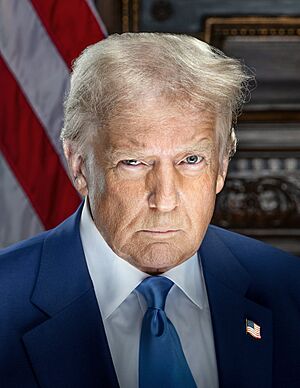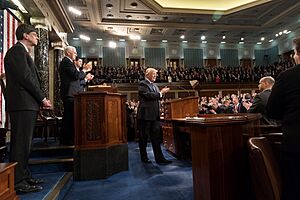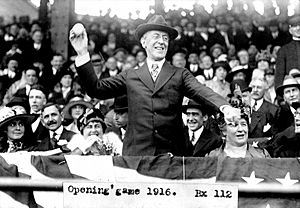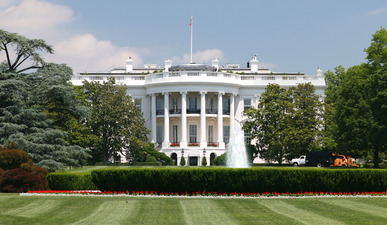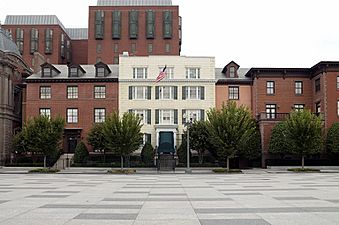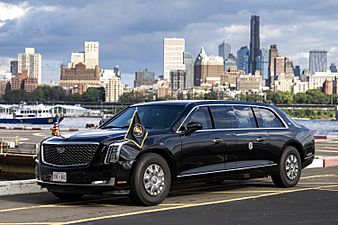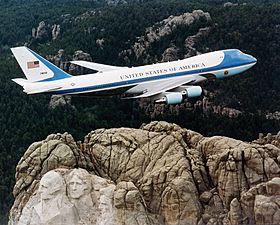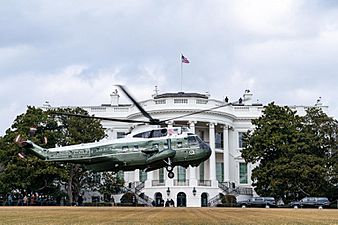President of the United States facts for kids
Quick facts for kids President of the United States |
|
|---|---|
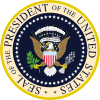
|
|
|
|
| Style |
|
| Abbreviation | POTUS |
| Member of | |
| Residence | White House |
| Seat | Washington, D.C. |
| Appointer | Electoral College or via succession |
| Term length | Four years, renewable once |
| Constituting instrument | Constitution of the United States |
| Formation | March 4, 1789 |
| First holder | George Washington |
| Salary | $400,000 per year |
The president of the United States (often called POTUS) is the top leader of the United States. This person is both the head of state (the symbolic leader of the country) and the head of government (the person in charge of running the government). The president leads the executive branch of the government. They are also the commander-in-chief of the U.S. military.
Since the first president, George Washington, took office in 1789, the president's power has grown a lot. Today, the U.S. president is one of the most powerful political figures in the world. They lead a country with the largest economy. This gives them a lot of influence both at home and around the world. For much of the 20th century, especially during the Cold War, the U.S. president was often called "the leader of the free world".
Article II of the U.S. Constitution explains the executive branch and gives the president their powers. These powers include making sure federal laws are followed. The president also appoints many important government officials. These include diplomats, judges, and people who run federal agencies. The president is also mainly responsible for handling the country's foreign policy. This means they direct the world's most expensive military. This military also has the second-largest nuclear arsenal.
The president also plays a big part in making new laws and policies for the country. The Constitution gives the president the power to sign or veto laws passed by Congress. Because presidents are usually seen as leaders of their political parties, their ideas often shape new laws. Presidents also use executive orders and appoint judges to influence policy.
The president is chosen indirectly through the Electoral College. They serve a four-year term, along with the vice president. A president can only be elected twice, thanks to the Twenty-second Amendment, which was added in 1951. Sometimes, a vice president becomes president if the current president dies or resigns. So far, 45 different people have served as president. Donald Trump is the 47th and current president, starting on January 20, 2025.
Contents
How the Presidency Started
Early Ideas for a Leader
During the American Revolutionary War, the Thirteen Colonies decided to become independent states. They declared this in the Declaration of Independence on July 4, 1776. To work together against the British, they created a first constitution called the Articles of Confederation. This document started on March 1, 1781.
Under the Articles, the central government was weak. It could not make laws or collect taxes. It was more like a group of states working together. The leader of this group was called the president of the United States in Congress Assembled. This was mostly a ceremonial job, very different from the president we have today.
After the war ended in 1783, the states faced problems. Their economies were struggling, and there was unrest. Events like Shays' Rebellion showed that the Articles of Confederation were not strong enough.
Creating the President's Job
In 1787, leaders met at the Constitutional Convention in Philadelphia. They wanted to create a stronger government. They looked at how their own states were run. Most states had a weak leader and a strong legislature (law-making body). New York was different, with a strong governor.
Through many discussions, they created the job of president as described in the U.S. Constitution. They wanted a leader who was strong enough to run the country but not so strong that they could become a king.
Presidents Through History
Early Years (1789–1933)
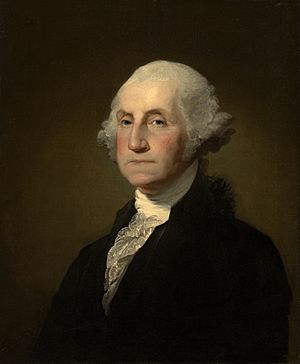
George Washington was the first president. He set many examples for future presidents. He decided to step down after two terms. This helped calm fears that the U.S. would become a monarchy. This two-term limit became a tradition until 1940. It was later made a permanent law by the 22nd Amendment.
After Washington, political parties began to form. John Adams won in 1796, in the first truly competitive election. Then, Thomas Jefferson, James Madison, and James Monroe (all from Virginia) served two terms each.
The election of Andrew Jackson in 1828 was a big moment. He was not from the wealthy families who had been president before. Jackson wanted to make the presidency stronger. He also wanted more people to be involved in politics. However, after him, the presidency became weaker for a while. Many presidents served only one term.
Abraham Lincoln led the country during the Civil War. Historians see him as one of the greatest presidents. The war made the presidency very powerful. Lincoln was the first president since Jackson to be re-elected. After Lincoln was assassinated, his successor, Andrew Johnson, almost lost his job. Congress remained powerful during this time.
In the early 1900s, Theodore Roosevelt changed the presidency a lot. He made the office stronger. He worked to break up big companies, protect nature, and improve workers' rights. Later, Woodrow Wilson led the U.S. during World War I.
Modern Presidency (1933-Today)

The presidency became even more powerful with Franklin D. Roosevelt in 1933. He led the country through the Great Depression and World War II. His "New Deal" programs made the government much bigger. He was elected four times, which was unheard of. This made the U.S. president a global leader.
After Roosevelt, presidents like Harry Truman and Dwight D. Eisenhower served two terms each during the Cold War. The president was seen as the "leader of the free world". John F. Kennedy was a young and popular leader. He used television to connect with people.
After the Vietnam War and the Watergate scandal, Congress tried to limit the president's power. However, presidents like Ronald Reagan used their communication skills to shape the country's direction.
In recent times, presidents like Bill Clinton, George W. Bush, and Barack Obama have served two terms. The country has become more politically divided. Presidents now often use executive orders and appoint judges to make big changes. This is because it's harder to pass new laws through Congress.
What the President Does
Legislative Powers
The Constitution says that Congress makes laws. But the president has a big role in this process.
Signing and Vetoing Bills
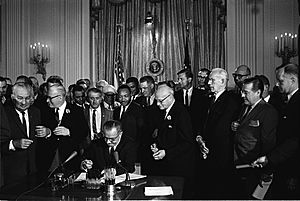
The president's most important power in lawmaking is the veto. If Congress passes a bill, the president can veto it. This means the bill does not become law. Congress can override a veto, but it needs a two-thirds vote in both houses. This is very hard to do.
When a bill reaches the president, they have three choices:
- Sign the bill within ten days (not counting Sundays). Then it becomes law.
- Veto the bill and send it back to Congress with their reasons. It won't become law unless Congress overrides the veto.
- Do nothing for ten days. If Congress is still in session, the bill becomes law. If Congress has ended its session, the bill does not become law. This is called a pocket veto.
Setting the Agenda
Presidents often run for office with promises of what laws they will try to pass. The Constitution asks the president to suggest ideas for laws to Congress. They do this in the State of the Union address each year. They also talk to members of Congress.
The president can suggest, ask for, or even insist that Congress pass certain laws. They can also try to change laws while they are being discussed in Congress. Only members of Congress can officially introduce a bill. But the president and their team can help write bills. They can also threaten to veto a bill if it's not changed.
Making Rules (Regulations)
Many laws passed by Congress don't include every small detail. They often let federal agencies fill in the details. As the head of the executive branch, the president controls many agencies. These agencies can make rules (called regulations) with little oversight from Congress.
Presidents can also manage the government by issuing directives. These include executive orders. These orders can be reviewed by courts to make sure they are constitutional. Congress can also pass a law to overturn an executive order.
Executive Powers
The president is the head of the executive branch. Their main job is to make sure laws are "faithfully executed." The executive branch has over four million employees, including the military.
Running the Government
Presidents make many appointments to government jobs. A new president can appoint up to 4,000 people. About 1,200 of these need to be approved by the U.S. Senate. This includes Ambassadors and members of the Cabinet.
The president also has a large staff to help them manage the government. This staff is part of the Executive Office of the President of the United States. The closest aides work in the White House Office.
Foreign Affairs
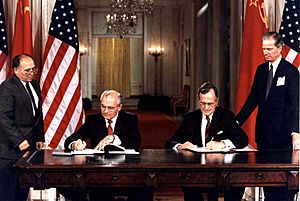
The Constitution says the president "receive Ambassadors." This means the president has a lot of power over foreign policy. They decide which foreign governments the U.S. recognizes. The president also appoints U.S. ambassadors to other countries. They lead the talks for agreements between the U.S. and other nations. These agreements become law if the Senate approves them by a two-thirds vote.
In modern times, presidents meet directly with leaders of other countries. This has made their power in foreign affairs even greater.
Commander-in-Chief
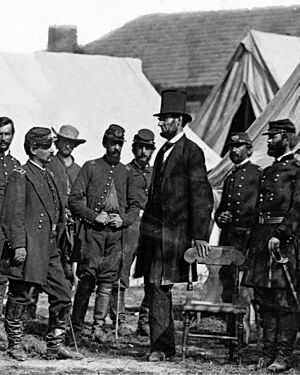
One of the president's most important jobs is being commander-in-chief of the United States Armed Forces. Only Congress can declare war. But the president is in charge of leading the military. The Constitution's framers wanted to limit the president's military power. Alexander Hamilton explained that the president commands the military, but Congress declares war and raises armies.
Today, Congress must approve any troop deployments longer than 60 days. Congress also controls military spending. Presidents have often started military actions without a formal declaration of war. Examples include the Korean War and the Vietnam War.
Presidents have handled military details differently. George Washington showed that the military is under civilian (non-military) control. Abraham Lincoln was very involved in the strategy of the Civil War. Today, the military is run by the Department of Defense. The Secretary of Defense and the chairman of the Joint Chiefs of Staff help the president.
Judicial Powers
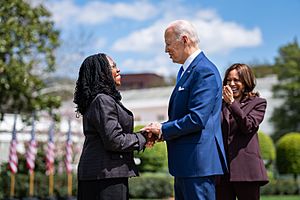
The president nominates federal judges. This includes judges for the United States courts of appeals and the Supreme Court of the United States. These nominations need to be approved by the Senate. Getting Senate approval can be a big challenge for presidents. Presidents can also grant pardons and reprieves. For example, Gerald Ford pardoned Richard Nixon after he resigned. Presidents often grant pardons just before they leave office.
Presidents also have special powers like executive privilege. This allows them to keep some communications private. George Washington first used this power. However, the Supreme Court has ruled that this privilege is not absolute. It cannot be used to hide from criminal investigations or civil lawsuits.
Another power is the state secrets privilege. This allows the president to keep information secret if releasing it would harm national security. This power has been used more often since the September 11 attacks.
Leadership Roles
Head of State
As the head of state, the president represents the U.S. to its own people and to the world. For example, when a foreign leader visits, the president hosts a special ceremony and a dinner.
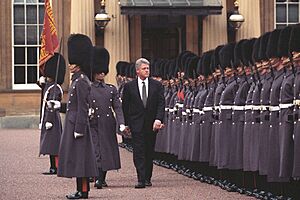
The president also does many less formal, ceremonial things. For example, William Howard Taft started the tradition of throwing out the ceremonial first pitch at baseball games in 1910. Every president since Theodore Roosevelt has been the honorary president of the Boy Scouts of America.
Other traditions involve holidays. Rutherford B. Hayes started the White House egg rolling in 1878. Every Thanksgiving since 1947, the president is given a live turkey. Since 1989, the president has "pardoned" the turkey, sending it to a farm to live out its life.
Presidents also give advice to their successors. Ronald Reagan and later presidents have left a private message for the new president in the Oval Office on Inauguration Day.
The modern presidency makes the president a famous person. Some people think the image of the president is carefully managed by public relations teams. This can make people have very high expectations for what a president can do.
Head of Party
The president is usually seen as the leader of their political party. When a president is elected, it often helps other candidates from their party win elections too. This is called the "coattail effect." However, there can be disagreements between a president and other members of their party in Congress.
Global Leader
Since the 20th century, the United States has become a superpower. It has the world's largest economy. Because of this, the U.S. president is often seen as a global leader. The U.S. is a key member of NATO and has strong ties with other democratic nations. This has led to the president being called the "leader of the free world".
How a President is Chosen
Who Can Be President?
To be president, a person must:
- Be a natural-born citizen of the U.S.
- Be at least 35 years old.
- Have lived in the U.S. for at least 14 years.
There are also some things that can stop someone from being president:
- If they have been impeached, convicted, and disqualified from public office by Congress.
- If they swore an oath to support the Constitution and then rebelled against the U.S. (though Congress can remove this disqualification).
- They cannot be elected president more than twice (due to the Twenty-second Amendment).
Campaigns and Nomination
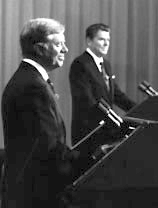
The journey to become president starts with primary elections. These are held by the two main political parties to choose their best candidate. Then, at national conventions, the party officially picks its presidential nominee. The presidential candidate usually chooses a vice presidential nominee, and the convention approves this choice. Many presidents were lawyers before they took office.
Candidates take part in televised debates. They travel around the country to share their ideas, convince voters, and raise money. A big part of modern campaigns is winning over voters in "swing states" through visits and ads.
Election Day
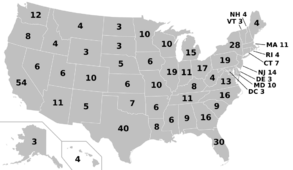
The president is not chosen directly by popular vote. Instead, they are elected by the Electoral College. This is a group of electors formed every four years. Each state gets a certain number of electors based on its population. Most states give all their electoral votes to the candidate who wins the popular vote in that state.
About six weeks after the election, the electors meet in their state capitals to vote. They usually vote for the candidate their state chose. Then, these votes are sent to Congress. In early January, Congress counts the votes. If a candidate gets at least 270 electoral votes, they win.
If no candidate gets enough electoral votes, the House of Representatives chooses the president. Each state delegation gets one vote. This has only happened twice in U.S. history: in 1800 and 1824.
Inauguration Day
The president's four-year term begins at noon on January 20. This day is called Inauguration Day. Before they can start their job, the president must say the presidential Oath of Office. This is the only part of the ceremony required by the Constitution:
I do solemnly swear (or affirm) that I will faithfully execute the Office of President of the United States, and will to the best of my ability, preserve, protect, and defend the Constitution of the United States.
Presidents usually place one hand on a Bible and add "So help me God" to the end of the oath. The Chief Justice usually gives the oath.
Being President
Term Limits
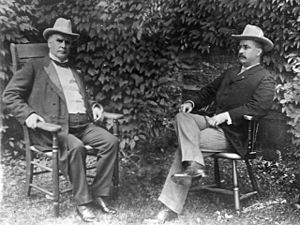
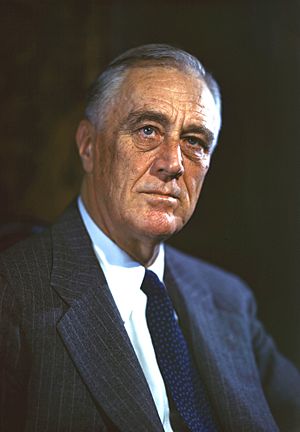
George Washington decided not to run for a third term. This set a tradition that presidents would serve only two terms. This tradition was followed for many years.
However, in 1940, Franklin Roosevelt was elected for a third term. He led the country through the Great Depression and World War II. He was elected a fourth time in 1944, but died shortly after.
Because of Roosevelt's long time in office, the Twenty-second Amendment was added in 1951. This amendment limits a person to being elected president only twice. If someone serves more than two years of another president's term, they can only be elected once more.
What Happens if the President Can't Serve?
The Twenty-fifth Amendment, added in 1967, explains what happens if the president leaves office, dies, or resigns. In these cases, the vice president becomes president. This has happened several times due to a president's death, and once when a president resigned.
If both the president and vice president cannot serve, Congress decides who will become acting president. The Presidential Succession Act of 1947 sets the order. First in line is the Speaker of the House, then the president pro tempore of the Senate, and then members of the president's cabinet in a specific order.
The president can also temporarily give their powers to the vice president. This happens if they know they will be unable to do their duties, like for surgery. The vice president becomes acting president. The president gets their powers back when they declare they are able to serve again. This has been used by Ronald Reagan, George W. Bush, and Joe Biden.
Removal from Office
The Constitution allows for the removal of high federal officials, including the president. This can happen for "treason, bribery, or other high crimes and misdemeanors". The House of Representatives can vote to impeach (accuse) a president by a majority vote. Then, the Senate holds a trial. If two-thirds of the Senate vote to convict, the president is removed from office.
Three presidents have been impeached by the House: Andrew Johnson (1868), Bill Clinton (1998), and Donald Trump (2019 and 2021). None of them were convicted by the Senate. Richard Nixon faced an impeachment inquiry but resigned before the House could vote.
Salary and Home
| Presidential pay history | ||
|---|---|---|
| Year established |
Salary | Salary in 2022 USD |
| 1789 | $25,000 | $Error when using : |start_year=1789 (parameter 3) is lower than the earliest available year (1800) in index "US". |
| 1873 | $50,000 | $1,221,389 |
| 1909 | $75,000 | $2,442,778 |
| 1949 | $100,000 | $1,229,930 |
| 1969 | $200,000 | $1,596,007 |
| 2001 | $400,000 | $661,079 |
| Sources: | ||
Since 2001, the president's yearly salary has been $400,000. They also get money for expenses, travel, and entertainment. Congress sets the president's salary. Any changes to the salary cannot happen until the next presidential term.
The White House in Washington, D.C. is the president's official home. George Washington chose the location, and the first cornerstone was laid in 1792. Every president since John Adams (in 1800) has lived there. Theodore Roosevelt officially named it the "White House" in 1901. The government pays for official events, but the president pays for their personal food and dry cleaning.
Camp David in Maryland is the president's country retreat. It's a quiet place often used to host foreign leaders. The President's Guest House, also known as Blair House, is next to the White House. It's used for official guests and as a backup home for the president.
- Presidential residences
-
White House, the official residence
-
Camp David in Frederick County, Maryland, the official retreat
-
Blair House, the official guest house
Travel
The president travels in special vehicles. For long-distance air travel, they use one of two Boeing VC-25 aircraft. These are modified Boeing 747s. When the president is on board, the plane is called Air Force One. For shorter flights, they use Marine Corps helicopters, called Marine One when the president is aboard.
For ground travel, the president uses the presidential state car. This is an armored limousine that looks like a Cadillac. The Secret Service manages these cars. The president also has armored buses for touring trips.
- Presidential transportation
-
The presidential plane, called Air Force One when the president is on board
-
The presidential helicopter, known as Marine One when the president is aboard
Protection
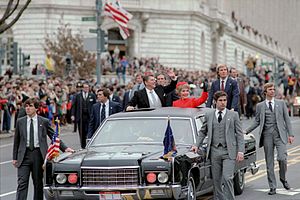
The U.S. Secret Service protects the president and their family. They use special Secret Service codenames for security reasons. These names are now mostly for tradition and clarity.
Life After Being President
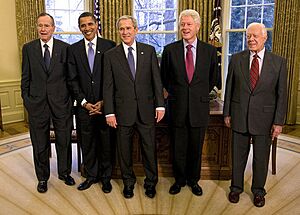
Many former presidents have continued to be active after leaving office. For example, William Howard Taft became the chief justice of the United States. Grover Cleveland was elected president again four years after losing his re-election bid. Donald Trump also won a second term after losing his re-election bid.
Some ex-presidents have been very involved in international affairs. Jimmy Carter became a global human rights activist. Bill Clinton and George W. Bush have worked together on humanitarian efforts after disasters. Former presidents often act as informal ambassadors for the U.S.
Benefits for Former Presidents
The Former Presidents Act (FPA), passed in 1958, gives lifetime benefits to former presidents and their spouses. These include a monthly pension, medical care, health insurance, and Secret Service protection. They also get money for staff and office expenses. A president who is removed from office by impeachment does not get these benefits.
The pension for retired presidents is based on the salary of current cabinet secretaries. In 2012, it was $199,700 per year. Former presidents also get travel funds and free mailing privileges.
Before 1997, all former presidents and their families had Secret Service protection for life. In 1997, a law limited this protection to 10 years. But in 2013, a new law brought back lifetime Secret Service protection for all future presidents.
Presidential Libraries
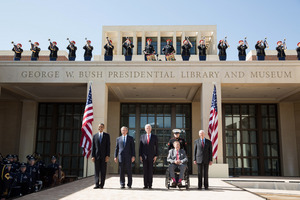
Every president since Herbert Hoover has created a presidential library. These libraries keep their papers, records, and other materials. The libraries are given to the National Archives and Records Administration (NARA) to maintain. The money to build them must come from private sources.
There are currently thirteen presidential libraries in the NARA system. Some presidential libraries also contain the graves of the presidents they document. These include the libraries for Harry S. Truman, Dwight D. Eisenhower, Richard Nixon, and Ronald Reagan. These gravesites are open to the public.
Political Parties of Presidents
Political parties have been a big part of American politics for most of its history. The Founding Fathers didn't expect parties to form. But they started appearing soon after the government began.
George Washington was worried that parties would divide the nation. He remained independent and was never part of a political party during his presidency. He is the only U.S. president who was not affiliated with a party when he took office. Since Washington, every president has been part of a political party.
Here's a list of presidents by their political party when they first took office:
Timeline of Presidents
This timeline shows the presidents and their political parties when they started their terms.
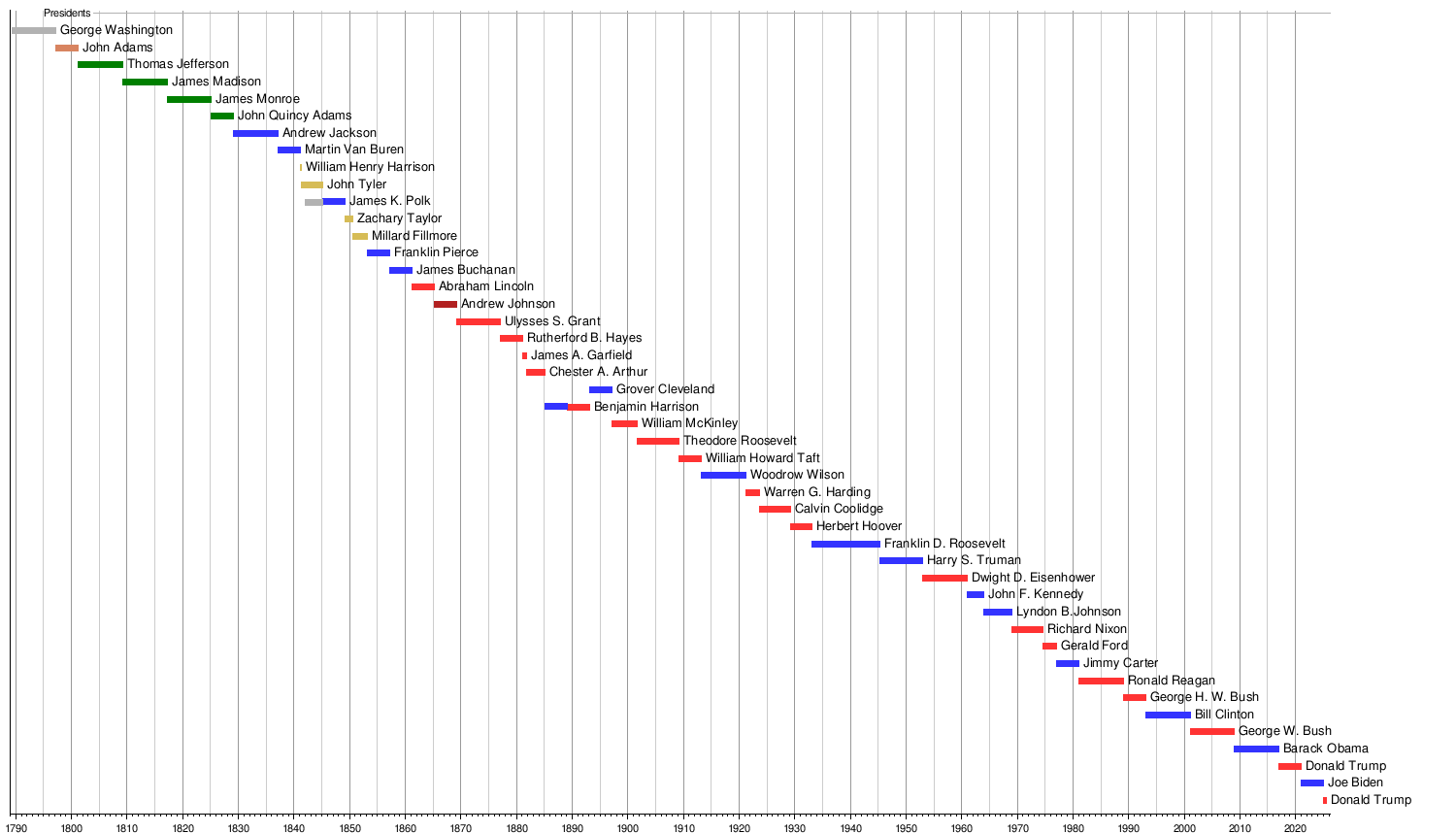
See also
 In Spanish: Presidente de los Estados Unidos para niños
In Spanish: Presidente de los Estados Unidos para niños
- Outline of American politics


